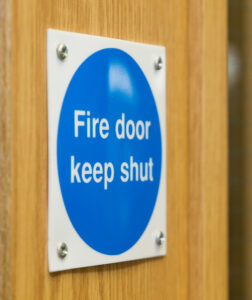With around 18 months spent working from home, many employees have only recently started returning to their workplaces. In this article, Darren Hockley, Managing Director at DeltaNet International reminds all employees of the importance of fire safety and how organisations can make sure fire doors are fully secured to protect employees from a potential outbreak.
Rubbish and Waste
Although it sounds logical, don’t let rubbish and waste build up in the office or communal areas. They must be disposed of and regularly emptied into the waste and recycling bins outside. Workplace rubbish often contains flammable materials, such as paper and cardboard, which becomes a fire safety risk.
Storage of flammable materials
Escape routes must remain clear of all flammable materials. This includes aerosol cans, drain cleaners and disinfectants, cooking oils, gas, heaters, damaged electrical cords, paper and dry waste, soft furnishing and polystyrene. While ensuring all these materials are as far away as possible may be difficult, it’s vital to have fire extinguishers in the correct locations should a time come when they are required.
Electrical equipment
Regularly inspect all electrical equipment to check for any defects, damage or deterioration of the electrical installation. Faulty electrical equipment could create sparks, another fire safety hazard.
Have the right equipment ready
At any emergency exit, having appropriate fire extinguishers at the ready is critical. Understand which fire extinguishers are required and suitable for your organisation.
- Carbon dioxide extinguishers tackle fires on electrical equipment and some flammable liquids.
- Powder extinguishers tackle fires on liquids and materials such as wood and paper.
- Foam extinguishers tackle liquids such as petrol, greases and fats, in addition to materials including wood, fabrics and paper.
- Water extinguishers tackle fires on wood, fabric and paper, however, they cannot work on electrical fires or flammable liquids.
- Fire blankets are crucial in the workplace if personal clothing catches fire.
Carry out a Fire Safety Risk Assessment
Employers are responsible for carrying out a fire safety risk assessment and reviewing it regularly. The assessment should:
- identify the fire hazards; identify anyone at risk
- evaluate, remove or reduce the risks
- record the findings, prepare an emergency plan and provide training to employees
- review and update the fire risk assessment regularly.
 Train employees on fire safety and emergency exit plans
Train employees on fire safety and emergency exit plans
Support employees with fire safety training so they know what procedures to follow and how to raise the alarm in case of a fire. Employees must understand where emergency fire exits are, where fire alarms are, how to exit calmly, whom to alert (e.g. fire station, fire wardens), and assembly points outside.
Fire Door Safety Top Tips
1) Keep fire doors closed. To prevent the spread of fire and smoke, keep fire doors shut at all times. It is also illegal to prop open a fire door as this could endanger lives, which means you could face fines or imprisonment for breaching fire health and safety laws.
2) Make sure fire doors are unlocked. Fire doors must not be locked because, when required to be used in an emergency, this can delay a swift, calm exit.
3) Do not obstruct fire doors. While its principal use is to prevent the spread of fire and smoke inside the workplace, it could also be used as an escape route if other fire exits are compromised.
4) Use correct seals on fire doors. Fire doors must have intumescent seals around the door frame. These seals will expand if they come into contact with heat, preventing the fire from moving between the cracks. Checking the seals are in full-working condition regularly and haven’t been torn is critical.
5) Fire doors must shut tightly. If an employee uses a fire door during a fire emergency, they shouldn’t have to worry about closing the door tightly behind them. Fire doors must shut tightly using their own self-closing mechanism, therefore automatically closing once opened in an evacuation.
6) Fire doors must have three hinges. Legally, fire doors must have at least three steel hinges firmly fixed, with no missing or broken screws.
7) Secure fire door handles. As simple as it sounds, it’s necessary to check if the door handles are secure and there are no loose screws that could result in a safety hazard. As fire doors can be heavy, it will be tough to open a fire door without a handle, and in emergencies, this could be dangerous.
8) Check the gaps around fire doors. When the fire door is closed, it’s critical to check that the gaps around all the top and sides of the door are less than 4mm. The gap under the door can be slightly bigger, however, it depends on the type of door used. It’s best if you can’t see light underneath the door. Minimising the gaps around the fire door can further prevent fire or smoke from travelling through the cracks into other parts of the building.


